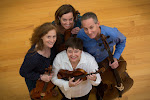I have always found it insight-producing to play a composition to the composer in preparing for performance. If it is a commissioned work, brand new, of course it is especially helpful simply to make sure the indications and instructions are being properly interpreted and are conveying what the composer intends, and to catch any mistakes in the notation.
I have enjoyed the tremendous privilege of playing to various composers over my 30 years as a performer, including young composers still learning or honing their craft in university, but also towering figures such as Aaron Copland and Elliott Carter. My musical journey has most recently presented the opportunity to play to Jennifer Higdon, as part of the Serafin String Quartet’s current recording project.
I have also played to George Rochberg, Jacob Druckman, Martin Bresnick, Maurice Wright, and a score of younger, wonderful, but not as well-established composers. In each and every case, it is a mind-opening experience and produces insights that help to understand the individual composer’s personality, compositional process, style and “lexicon”.
Serafin Quartet often plays to college-level composition students. Usually the aspiring composers are hearing their composition performed for the first time (other than through a midi file or keyboard). After playing the composition to them, we often ask them if it sounds as they had imagined it would, or was anything surprising. Their answers are diverse – some are excited to hear how it sounds, and some are disappointed in the results. Sometimes we try adjustments to tempo or character to try to get at what they intended. Then we discuss how they might want to mark indications differently to more precisely convey their intentions for times when they are not present to converse directly with the performers. We explain how their indications or lack of indications leads us, especially as string players, to respond with tempo choices, strokes, dynamic changes, bowings, stylistic character, and phrasing. We explore how we play in response to one marking versus another – for example, if we see a line or dot over a note, slurs or no slurs - and we explain and demonstrate how the indications encourage us to play in one manner or another.
Working with Jennifer Higdon on our upcoming Naxos release of her early chamber works was especially gratifying. She was so positive and encouraging about our approach to interpreting her works and the results we were getting. (It is affirming to hear that one’s interpretation is hitting the mark for the creator of the work!)
Also, she shared freely what she is after in the pieces we played to her, and even what was going on in her life that prompted the emotional content – confirming that we were finding the right emotional landscape in the work, although we had known nothing of specific personal experiences the work reflected. We also learned about her polyphonic inclinations – the idea that, in many sections, she wanted independent lines to interweave, rather than a line or lines standing out in clear relief. This gave us greater insight into how to approach the balancing of intricately intertwined lines. And we were able to confirm that in these works she was not feeling absolute strictness in a given tempo – that it was ok with her if the music moved a little faster or slower than specific tempo markings.
In every case, the insights from meeting and spending time with the composer are meaningful. Even when the composer (as was Elliott Carter) is quieter and introverted – it is meaningful to feel his/her energy, to experience wit and/or seriousness, to observe where their ideas and expression seem to reside (“head” or “heart”, for example. It all helps the interpreter to feel more confident and assured about choosing a direction in deciding how to play the content of the music. Then, our technical choices can reflect more closely and deeply the inner workings of the composer’s creative soul.
I treasure that place where we, the “interpreters”, meet the composer – the “creator”, whether in-person or simply from the pages of history and musical scores. It is a special intersection and a privilege to meet there!
--Kate Ransom


No comments:
Post a Comment